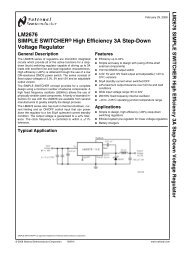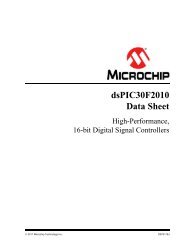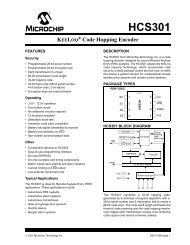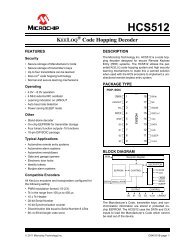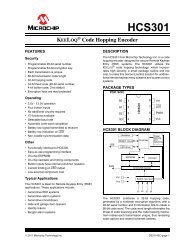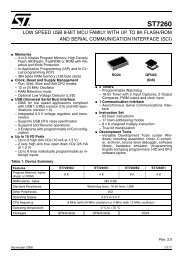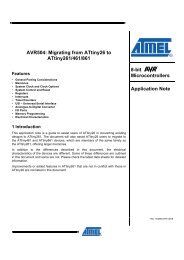You also want an ePaper? Increase the reach of your titles
YUMPU automatically turns print PDFs into web optimized ePapers that Google loves.
System modules<br />
<strong>STM32W108C8</strong><br />
6.1 Power domains<br />
The <strong>STM32W108C8</strong> contains three power domains:<br />
●<br />
●<br />
●<br />
An "always on domain" containing all logic and analog cells required to manage the<br />
<strong>STM32W108C8</strong>'s power modes, including the GPIO controller and sleep timer. This<br />
domain must remain powered.<br />
A "core domain" containing the CPU, Nested Vectored Interrupt Controller (NVIC), and<br />
peripherals. To save power, this domain can be powered down using a mode called<br />
deep sleep.<br />
A "memory domain" containing the RAM and flash memories. This domain is managed<br />
by the power management controller. When in deep sleep, the RAM portion of this<br />
domain is powered from the always-on domain supply to retain the RAM contents while<br />
the regulators are disabled. During deep sleep the flash portion is completely powered<br />
down.<br />
6.1.1 Internally regulated power<br />
The preferred and recommended power configuration is to use the internal regulated power<br />
supplies to provide power to the core and memory domains. The internal regulators<br />
(VREG_1V25 and VREG_1V8) generate nominal 1.25 V and 1.8 V supplies. The 1.25 V<br />
supply is internally routed to the core domain and to an external pin. The 1.8 V supply is<br />
routed to an external pin where it can be externally routed back into the chip to supply the<br />
memory domain. The internal regulators are described in Section 7: Integrated voltage<br />
regulator on page 53.<br />
When using the internal regulators, the always-on domain must be powered between 2.1 V<br />
and 3.6 V at all four VDD_PADS pins.<br />
When using the internal regulators, the VREG_1V8 regulator output pin (VREG_OUT) must<br />
be connected to the VDD_MEM, VDD_PADSA, VDD_VCO, VDD_RF, VDD_IF, VDD_PRE,<br />
and VDD_SYNTH pins.<br />
When using the internal regulators, the VREG_1V25 regulator output and supply requires a<br />
connection between both VDD_CORE pins.<br />
6.1.2 Externally regulated power<br />
Optionally, the on-chip regulators may be left unused, and the core and memory domains<br />
may instead be powered from external supplies. For simplicity, the voltage for the core<br />
domain can be raised to nominal 1.8 V, requiring only one external regulator. Note that if the<br />
core domain is powered at a higher voltage (1.8 V instead of 1.25 V) then power<br />
consumption increases. A regulator enable signal, REG_EN, is provided for control of<br />
external regulators. This is an open-drain signal that requires an external pull-up resistor. If<br />
REG_EN is not required to control external regulators it can be disabled (see Section 8.1.3:<br />
Forced functions on page 57).<br />
Using an external regulator requires the always-on domain to be powered between 1.8 V<br />
and 3.6 V at all four VDD_PADS pins.<br />
When using an external regulator, the VREG_1V8 regulator output pin (VREG_OUT) must<br />
be left unconnected.<br />
When using an external regulator, this external nominal 1.8 V supply has to be connected to<br />
both VDD_CORE pins and to the VDD_MEM, VDD_PADSA, VDD_VCO, VDD_RF, VDD_IF,<br />
VDD_PRE and VDD_SYNTH pins.<br />
33/215 Doc ID 018587 Rev 2





